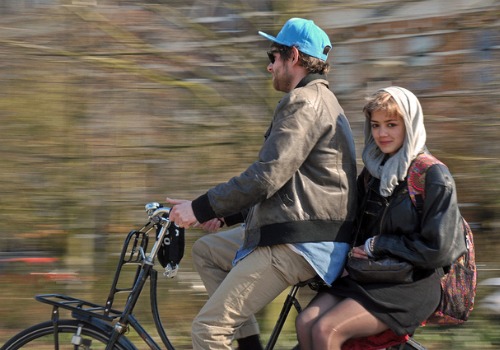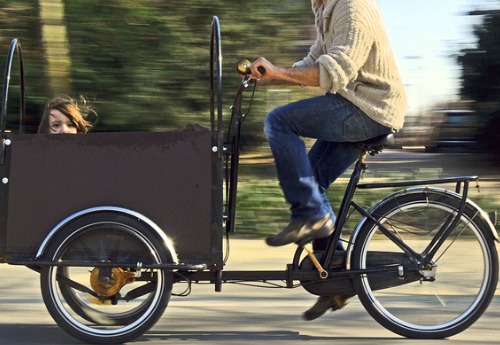 A chic couple in Amsterdam.Photo: Marc van WoudenbergCheck out our Cycle Chic slideshow.
A chic couple in Amsterdam.Photo: Marc van WoudenbergCheck out our Cycle Chic slideshow.
Back in 2006, Mikael Colville-Andersen took a picture in Copenhagen of a group of bicyclists waiting for the light to change. One woman in particular stands out: smartly dressed, wearing a stylish skirt, she is silhouetted against the light, poised to move forward.
Colville-Andersen, who blogs at Copenhagenize and Copenhagen Cycle Chic, says this is “the shot that launched the movement” of Cycle Chic (yes, he’s trademarked the phrase).
What is that movement about? Well, here’s how Marc van Woudenberg, of kindred spirit Amsterdamize, explained it to me in an email:
Cycle Chic basically puts the emphasis on “normal” cycling: people in normal (everyday) clothes on “normal” (city) bikes. As opposed to countries where the sport cycling industry dominates the market and has generated and perpetuates the perception that cycling is for the few, you need all that gear, etc. So, it’s the movement for the rehumanification of cycling in countries where people have lost touch with how normal cycling is & that it’s not inherently dangerous.
In countries like US, UK & AUS many people mistake Cycle Chic for “having to dress up.” It couldn’t be more farther from the truth: you have a closet? Open it! If you can walk (in) it, you can cycle (in) it.
As I heard Colville-Andersen explain in a talk once, people in Copenhagen don’t think about “Cycle Culture” any more than they do “Vacuum Cleaner Culture.” They have cycles and vacuum cleaners to help them perform tasks. It’s not an identity thing.
Although I do notice there is no “Vacuum Cleaner Chic” movement.
You can find the Cycle Chic manifesto here. And there’s a list of Cycle Chic blogs from around the world at Copenhagen Cycle Chic, Colville-Andersen’s original.
Oh, and yes: I know the people in the pictures aren’t wearing helmets. In many of the (mostly European) countries where Cycle Chic is a way of life and cycling infrastructure is robust and respected, they tend not to. You can read Colville-Andersen’s thoughts on the subject here, and leave your own in the comments.
Many thanks to those who contributed photos, including van Woudenberg, Colville-Andersen, and Noa Cortes of New York Cycle Chic.



